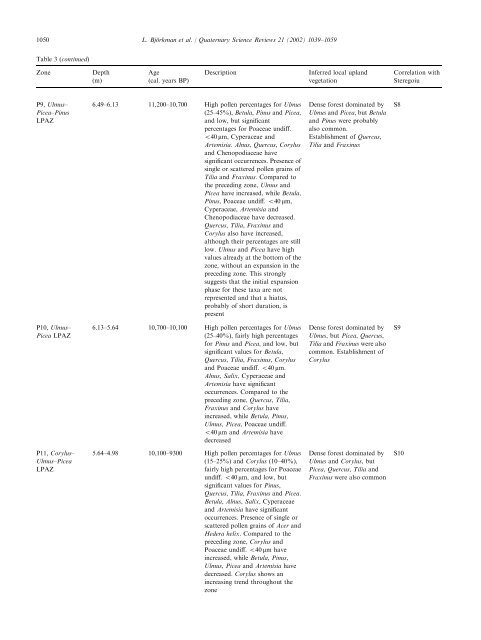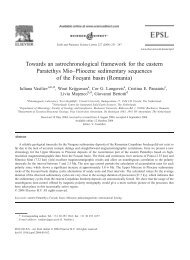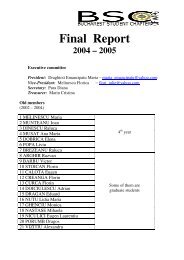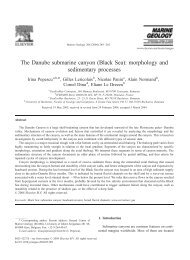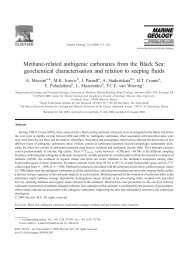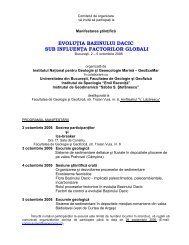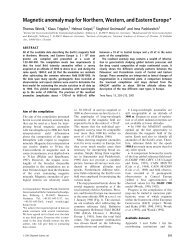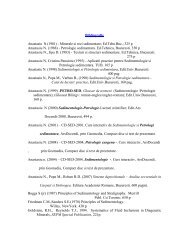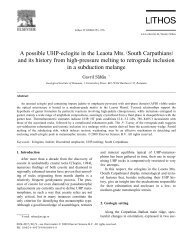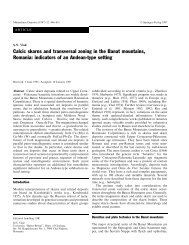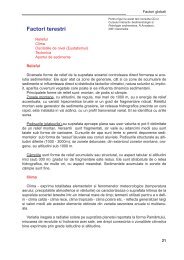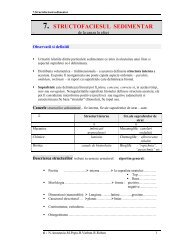Lateglacial and early Holocene vegetation ... - geo.edu.ro
Lateglacial and early Holocene vegetation ... - geo.edu.ro
Lateglacial and early Holocene vegetation ... - geo.edu.ro
Create successful ePaper yourself
Turn your PDF publications into a flip-book with our unique Google optimized e-Paper software.
1050<br />
L. Bj .orkman et al. / Quaternary Science Reviews 21 (2002) 1039–1059<br />
Table 3 (continued)<br />
Zone<br />
Depth<br />
(m)<br />
Age<br />
(cal. years BP)<br />
Description<br />
Inferred local upl<st<strong>ro</strong>ng>and</st<strong>ro</strong>ng><br />
<st<strong>ro</strong>ng>vegetation</st<strong>ro</strong>ng><br />
Correlation with<br />
Steregoiu<br />
P9, Ulmus–<br />
Picea–Pinus<br />
LPAZ<br />
6.49–6.13 11,200–10,700 High pollen percentages for Ulmus<br />
(25–45%), Betula, Pinus <st<strong>ro</strong>ng>and</st<strong>ro</strong>ng> Picea,<br />
<st<strong>ro</strong>ng>and</st<strong>ro</strong>ng> low, but significant<br />
percentages for Poaceae undiff.<br />
o40 mm, Cyperaceae <st<strong>ro</strong>ng>and</st<strong>ro</strong>ng><br />
Artemisia. Alnus, Quercus, Corylus<br />
<st<strong>ro</strong>ng>and</st<strong>ro</strong>ng> Chenopodiaceae have<br />
significant occurrences. Presence of<br />
single or scattered pollen grains of<br />
Tilia <st<strong>ro</strong>ng>and</st<strong>ro</strong>ng> Fraxinus. Compared to<br />
the preceding zone, Ulmus <st<strong>ro</strong>ng>and</st<strong>ro</strong>ng><br />
Picea have increased, while Betula,<br />
Pinus, Poaceae undiff. o40 mm,<br />
Cyperaceae, Artemisia <st<strong>ro</strong>ng>and</st<strong>ro</strong>ng><br />
Chenopodiaceae have decreased.<br />
Quercus, Tilia, Fraxinus <st<strong>ro</strong>ng>and</st<strong>ro</strong>ng><br />
Corylus also have increased,<br />
although their percentages are still<br />
low. Ulmus <st<strong>ro</strong>ng>and</st<strong>ro</strong>ng> Picea have high<br />
values already at the bottomof the<br />
zone, without an expansion in the<br />
preceding zone. This st<strong>ro</strong>ngly<br />
suggests that the initial expansion<br />
phase for these taxa are not<br />
represented <st<strong>ro</strong>ng>and</st<strong>ro</strong>ng> that a hiatus,<br />
p<strong>ro</strong>bably of short duration, is<br />
present<br />
Dense forest dominated by<br />
Ulmus <st<strong>ro</strong>ng>and</st<strong>ro</strong>ng> Picea, but Betula<br />
<st<strong>ro</strong>ng>and</st<strong>ro</strong>ng> Pinus were p<strong>ro</strong>bably<br />
also common.<br />
Establishment of Quercus,<br />
Tilia <st<strong>ro</strong>ng>and</st<strong>ro</strong>ng> Fraxinus<br />
S8<br />
P10, Ulmus–<br />
Picea LPAZ<br />
6.13–5.64 10,700–10,100 High pollen percentages for Ulmus<br />
(25–40%), fairly high percentages<br />
for Pinus <st<strong>ro</strong>ng>and</st<strong>ro</strong>ng> Picea, <st<strong>ro</strong>ng>and</st<strong>ro</strong>ng> low, but<br />
significant values for Betula,<br />
Quercus, Tilia, Fraxinus, Corylus<br />
<st<strong>ro</strong>ng>and</st<strong>ro</strong>ng> Poaceae undiff. o40 mm.<br />
Alnus, Salix, Cyperaceae <st<strong>ro</strong>ng>and</st<strong>ro</strong>ng><br />
Artemisia have significant<br />
occurrences. Compared to the<br />
preceding zone, Quercus, Tilia,<br />
Fraxinus <st<strong>ro</strong>ng>and</st<strong>ro</strong>ng> Corylus have<br />
increased, while Betula, Pinus,<br />
Ulmus, Picea, Poaceae undiff.<br />
o40 mm<st<strong>ro</strong>ng>and</st<strong>ro</strong>ng> Artemisia have<br />
decreased<br />
Dense forest dominated by<br />
Ulmus, but Picea, Quercus,<br />
Tilia <st<strong>ro</strong>ng>and</st<strong>ro</strong>ng> Fraxinus were also<br />
common. Establishment of<br />
Corylus<br />
S9<br />
P11, Corylus–<br />
Ulmus–Picea<br />
LPAZ<br />
5.64–4.98 10,100–9300 High pollen percentages for Ulmus<br />
(15–25%) <st<strong>ro</strong>ng>and</st<strong>ro</strong>ng> Corylus (10–40%),<br />
fairly high percentages for Poaceae<br />
undiff. o40 mm, <st<strong>ro</strong>ng>and</st<strong>ro</strong>ng> low, but<br />
significant values for Pinus,<br />
Quercus, Tilia, Fraxinus <st<strong>ro</strong>ng>and</st<strong>ro</strong>ng> Picea.<br />
Betula, Alnus, Salix, Cyperaceae<br />
<st<strong>ro</strong>ng>and</st<strong>ro</strong>ng> Artemisia have significant<br />
occurrences. Presence of single or<br />
scattered pollen grains of Acer <st<strong>ro</strong>ng>and</st<strong>ro</strong>ng><br />
Hedera helix. Compared to the<br />
preceding zone, Corylus <st<strong>ro</strong>ng>and</st<strong>ro</strong>ng><br />
Poaceae undiff. o40 mmhave<br />
increased, while Betula, Pinus,<br />
Ulmus, Picea <st<strong>ro</strong>ng>and</st<strong>ro</strong>ng> Artemisia have<br />
decreased. Corylus shows an<br />
increasing trend th<strong>ro</strong>ughout the<br />
zone<br />
Dense forest dominated by<br />
Ulmus <st<strong>ro</strong>ng>and</st<strong>ro</strong>ng> Corylus, but<br />
Picea, Quercus, Tilia <st<strong>ro</strong>ng>and</st<strong>ro</strong>ng><br />
Fraxinus were also common<br />
S10


